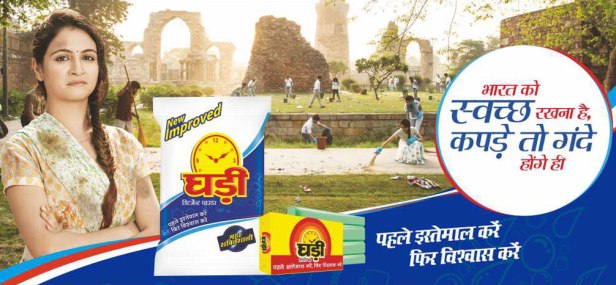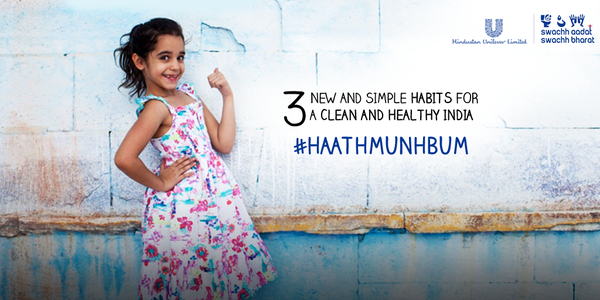Brands associating themselves to a larger social cause
Have you heard of Real Time Social Media? Its supposedly a new tactic for marketers to capitalize on trending topics through discussions on social media for the brand’s benefit.
What if I tell you that this isn’t a new thing or just confined to the online world. Several brands have piggy banked on trending topics or revolutions and have proven to be beneficial for the brand in the process. The rules of the game remain similar, you chose the trends relevant to your brand, look for ways to add value without compromising on the Brand Voice and if necessary give your audience a fresh perspective about the topic.
Whether Narendra Modi’s Swachha Bharat Abhiyan has been successful so far is debatable, but brands have been hugely successful in following the bandwagon and associating themselves with the mission.
One of the early adopters was Ghari Detergent which came up with two TVCs in early 2015 – one in Hindi, for its Hindi speaking base and the other in Bangla as it’s been struggling to gain market share in West Bengal. Both ads showcased people realizing that every road, vehicle, place they visit comprises what we call ‘India’ and that Ghari detergent supported the mission putting in earnest efforts to make India clean. The voiceover says “Jaise Aapne Sankalp Liya Hai Bharat Ko Behtar Banane Ka, Vaise Hi Humne Bhi Sankalp Liya Hai Behtar Ko Aur Behtar Karne Ka.”
 While the campaign presents the backyard of Qutub Minar and the ‘padas’ of Kolkata, way too dirtier than in reality, what I liked about the campaign is that it very strongly drives down the essence of the Swachh Bharat Abhiyan. It pricks the audience at the right place, raising the matter of responsibility, leaving it completely upto us to treat our environment as our own and taking the onus of keeping it clean as well. The wise product placement stating that in the process of cleaning, clothes are meant to get dirty and that Ghari Detergent would take care of that, makes the exercise relevant to the brand. Further it reinforces it by weaving it in the campaign line, “Hamara Sankalp ki Hum Banaye Kuchh Behetar”. Thus it scores high on relevancy, integration with the brand proposition and extendibility of the campaign.
While the campaign presents the backyard of Qutub Minar and the ‘padas’ of Kolkata, way too dirtier than in reality, what I liked about the campaign is that it very strongly drives down the essence of the Swachh Bharat Abhiyan. It pricks the audience at the right place, raising the matter of responsibility, leaving it completely upto us to treat our environment as our own and taking the onus of keeping it clean as well. The wise product placement stating that in the process of cleaning, clothes are meant to get dirty and that Ghari Detergent would take care of that, makes the exercise relevant to the brand. Further it reinforces it by weaving it in the campaign line, “Hamara Sankalp ki Hum Banaye Kuchh Behetar”. Thus it scores high on relevancy, integration with the brand proposition and extendibility of the campaign.
Ghari Detergent, a 4000Cr. plus brand, with a wide-spread mass market foothold, has a big first mover’s advantage here. Since association with this Abhiyaan is quite direct for any cleaning related brand, the opportunity was large for everyone. But whosoever moved first, got the cream.
If you contemplate more on the proposition of this campaign, Ghari’s communication closely resembles to that of the Unilever’s “Daag Achhe Hain” campaign which clearly states stains are perfectly fine as long they occur while doing something good. But the brand is associating itself with a noble cause, making the uphill task look more achievable, thereby not only coming closer to its audience but also raising the imagery of the brand in the consumers’ minds.
HUL on the other hand launched its Swachh Aadat, Swachh Bharat campaign in Dec 2015. It’s a more over arching strategy tieing together 3 brands from its stable – Lifebuoy, Pureit and Domex. The ad jingle states “Haath, Munh Aur Bum, Bimari Hogi Kum”. The campaign propagates three simple healthy habits that can foster good health in long term.

This campaign adds value by propagating the fact that embracing sanitary habits is also an essential aspect of change viz a viz the development of sanitary infrastructure under the Swachha Bharat Abhiyaan. And it is this role that HUL is vying to take on itself. All three brands’ proposition tied to the same string and aligned well with the communication.
Another interesting aspect of the campaign is that children are shown taking the lead and preaching the gospel of cleanliness to their elder counterparts. This is bound to strike a chord with the younger audience who has a greater pester power. How much does it helps to drive the recall value of the brand is still debatable, but what this campaign definitely delivers is a strong and catchy phrase to inculcate good sanitary habits.
Certain brands like Lifebuoy have already been seen to be associated with such initiatives of driving Clean India through campaigns like “Help a Child Reach 5”. Even for that matter its competitor Dettol had a Banega Swachha India campaign trying to drive behavioral change towards hand hygiene. When they associate with such Abhiyan on a larger scale, it becomes easier for the audience to relate to it as they recall the brand along with such initiatives.
But it’s not necessary that only brands with direct association can benefit from such Abhiyans. It’s about how smartly and creatively you weave a believable Brand Story around it and have a convincing campaign that supports such noble causes. I think LIC has done a superb ad combining as many as 3 government mission, namely “Housing for all by 2022”, “Clean India” and “Beti Bachao, Beti Padhao” – where it talks about building a nation, where every single resident contributes to the progress of the nation. Brands can really establish a strong emotional connect with its audience and benefit from it in long term, if they can align themselves in the larger mission and vision of the growth story of the nation.
This article was also published as part of my regular column in Packaging South Asia.


